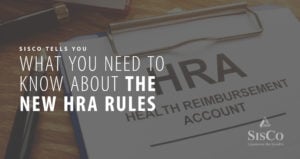Beginning January 1, 2020, there will be two new Health Reimbursement Arrangements: an Individual Coverage HRA and an Excepted Benefit HRA. While both are sensible options for employers to offer, there are a few distinctions to note for the IC-HRA and the EB-HRA.
IC-HRA
- For employees of all sizes
- Employees may be eligible if enrolled in individual health insurance or Medicare, but are not eligible if enrolled in a group health plan
- Reimbursable expenses include:
- 213(d) eligible expenses
- Individual health insurance premiums
- Medicare premiums
- Certain student health plans
- ACA compliant catastrophic health plans
EB-HRA
- For employees of all sizes who offer a group health plan
- Employees must be eligible for the group health plan to be eligible for the EB-HRA
- Maximum contribution is $1,800/year
- Unlimited carryovers but not included in annual limit - Reimbursable expenses include:
- 13(d) medical expenses
- Premiums of solely excepted benefits
- COBRA premiums - Short-term limited duration insurance
HOW THE NEW RULES AFFECT YOU AS AN EMPLOYER
Allowed to rollover up to $500 unused funds from the previous plan year to the next year Employers are incentivized to offer Health Reimbursement Arrangements to employees
because these plans have savings potential. For most companies, it’s less expensive to contribute to an IC-HRA than it is to fund a group health plan. This becomes a double-sided
benefit that saves both employers and employees money on health insurance. In addition, HRA contributions are considered non-taxable benefits.
Employers enjoy a certain level of control over their company’s Health Reimbursement Arrangements. The employer determines the maximum HRA allocation and decides which
expenses can be reimbursed through the HRA. However, employers must offer IC-HRAs on the same terms to all members within a specific class. Amounts offered to older employees and
employees with more dependents may be increased, but only up to three times that of other employees. Employers can offer IC-HRAs to one class of employees and a group health plan to
another class of employees (minimum class size required).







